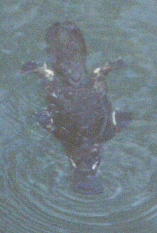|
 Platypus: Ormithorhynchus anatinus Platypus: Ormithorhynchus anatinus
- These are an egg laying mammal (monotreme) which are unmistakable out of water.
- When swimming they are distinguished from other Australian mammals by the absence
of visible ears
- It is also distinguished by its smooth swimming action and rolling dive.
- Most frequently seen at mid-distance in poor light. Dawn or Dusk.
- Have webbed forefeet which aid in swimming and although the hind feet are also
webbed, these are folded back against the tail, except when used for steering and as
brakes.
- The platypus is quite motile on land, but due to the webbing of the forefoot
which extends beyond the toes, it carries itself on its knuckles
- The fur is fine and dense with about eight hundred hairs per square millimetre.
There are two layers, a woolly undercoat and a long guard fur on top of that. Together,
these two layers trap air, therefore keeping the monotreme dry even after long periods of
being under water.
- The flat tail is used as a stabiliser during swimming as well as enabling quick
diving. The undersurface of the tail is bare.
- The size of the platypus varies with location.
Habitat:
- It is found in Australian fresh water lakes and streams.
- When out of the water the monotreme spends its time in burrows just above the
water level, in river or stream banks or under a gathering of tree roots. Its burrow is
distinguished by oval sections and it may also have two ends of entry or exit. These
burrows can be up to thirty metres long, particularly when the female is nursing her
young, an increase in tunnel length is a protection from predators and flooding.
Diet:
- The platypus eats fresh water insects and their larvae, shrimps, yabbies, worms,
tadpoles, small frogs and fish.
- Smaller prey is sifted from the bottom silt or gravel by the bill which is
pliable and very sensitive.
- When the platypus is under water, it closes its eyes, ears and nostrils. Most
information about its environment is obtained from electroreceptors in the skin of the
bill. The receptors enable it to identify electrical fields created by the muscle
movements of its prey.
- Food collected is stored in cheek pouches until the animal comes to the water
surface to rest and grind food between two hard pads in the bill. Juveniles have teeth,
but lose them as they mature into adults.
- The tail of the platypus stores fat for periods of low food supply, or for when
the female burrows to breed.
Social Behaviour:
- Platypus’ are solitary animals, but do tend to share small bodies of water.
- Males and females are differentiated by the males having a sharp hollow spur on
their hind legs which join to a gland in the groin which produces a venom capable of
causing great pain and incapacity in humans and can be lethal to small mammals.
Viewing Opportunities:
- They can be viewed early morning and late afternoon at the Chambers Wildlife
Rainforest Lodge platypus viewing area.
- They can be viewed up stream from the falls besides the walking path at the
Malanda Falls Environmental Park.
- Other viewing areas include the bridge over Maroobi Creek, the Petersen Creek
viewing area in Yungaburra and in front of the Atherton pump station on crossing road.
|
